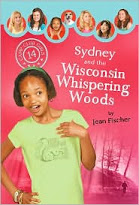Lemony Snicket, Severus Snape, Sludge, Petunia Periwinkle. I love funny or unusual names. When I stumble across one, I scribble it on a three-by-five card and store it in a small, plastic box on my desk. It’s a great help when I’m creating story characters. A unique name fashions an image in my mind. As I “see” the character, I form a basic idea of his or her personality. Imagine these colorful individuals romping through the pages of children’s books: Ruby Knuckles, Roman Peeples, Ivory Hunter, Clora Odora. Of course, naming characters is just the beginning. The real task is giving them life.
A great character-generating tool is a Look, Listen, and Learn Journal. To make one, you simply divide a notebook into three equal parts labeled Look, Listen, Learn. Then, follow these steps:

1. Look. Get into the habit of looking for interesting people. Some great people watching spots are train stations, airports, fast food restaurants, and other places that attract an eclectic mix of cultures, ages, and personalities. Choose one person. Then write a detailed description of him or her in the Look section of your journal. Try to do this every day, and include a wide variety of people. Focus just on what you see, and add details beyond a basic physical description. Ask yourself, “What is it about this person that provides clues to his or her individuality?” Look for things like facial expressions, gestures, a unique gait, and so on. When you write a story, this part of the journal will help your character development. How characters look and act provide clues about their personalities. You want to show readers who your characters are instead of tell them.
2. Listen. Tune in to conversations all around you. I know; it’s eavesdropping, but it’s also a great way to become keenly aware of dialogue – how real people sound when they’re having real conversations. Listen and make notes in the Listen section of your notebook. If you hear an interesting conversation that you think might work in a story, capture the essence in your journal. Also, listen for dialect and unusual words and phrases. Describe the different tones of voice that you hear and the unique ways that people pronounce individual words. For example, here’s a conversation that I heard between a couple in a hospital waiting room.
2. Listen. Tune in to conversations all around you. I know; it’s eavesdropping, but it’s also a great way to become keenly aware of dialogue – how real people sound when they’re having real conversations. Listen and make notes in the Listen section of your notebook. If you hear an interesting conversation that you think might work in a story, capture the essence in your journal. Also, listen for dialect and unusual words and phrases. Describe the different tones of voice that you hear and the unique ways that people pronounce individual words. For example, here’s a conversation that I heard between a couple in a hospital waiting room.
“Moira, those sure were good panacakes we had at the diner this morning.”
“Henry, ain’t ya glad I seen the coupon in the Handy Shopper?”
“Yeah. I sure liked them blueberry ones. Very tasty.”
“I meant to tell ya, Henry, but I forgot. They stained your dentures.”
Dialogue can provide an excellent starting point for character development. As you listen, try not to look. Let your imagination suggest an image of the person speaking. Listen for personality clues in tone and inflection.

Try this exercise: Write a paragraph that includes the dialogue between Moira and Henry. In your paragraph, show readers what the characters look like, and provide details that hint at their individual personalities. If you’d like, you may share your paragraph in the Comments section following this post.
3. Learn. The third step toward creating great characters is to learn about customs and cultures very different from your own. Pick a world nation, and learn about its people. Choose a period in the past, and discover how people lived. Find out about unique occupations, ethnic foods, and traditional dress. Try to do this at least weekly, and record your findings in the Learn section of your notebook. As you create characters for your stories, think about heritage. Where did your character, or his/her family come from? What customs might have been handed down through the generations?
3. Learn. The third step toward creating great characters is to learn about customs and cultures very different from your own. Pick a world nation, and learn about its people. Choose a period in the past, and discover how people lived. Find out about unique occupations, ethnic foods, and traditional dress. Try to do this at least weekly, and record your findings in the Learn section of your notebook. As you create characters for your stories, think about heritage. Where did your character, or his/her family come from? What customs might have been handed down through the generations?
 Some of the best fictional characters are based on real people. As you add to your Look, Listen, and Learn Journal, you will be creating a valuable character reference guide for your writing. Try it this week, and share some of your entries in the Comments section. I look forward to reading them.
Some of the best fictional characters are based on real people. As you add to your Look, Listen, and Learn Journal, you will be creating a valuable character reference guide for your writing. Try it this week, and share some of your entries in the Comments section. I look forward to reading them. 













0 comments:
Post a Comment